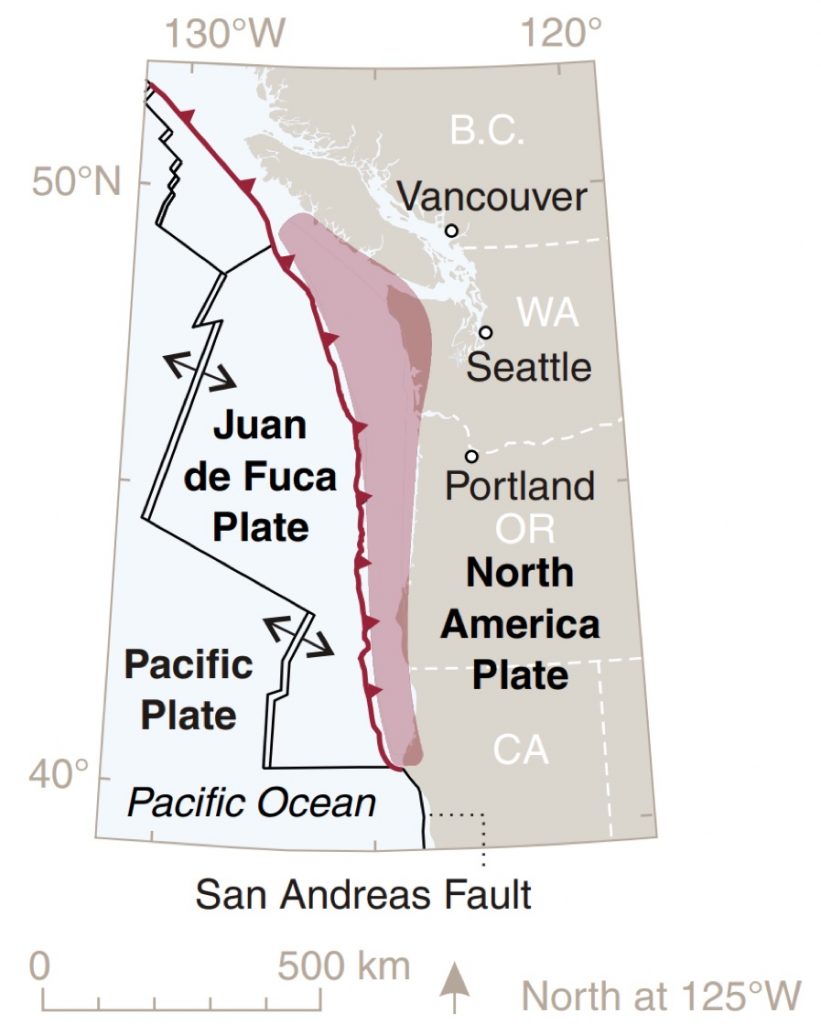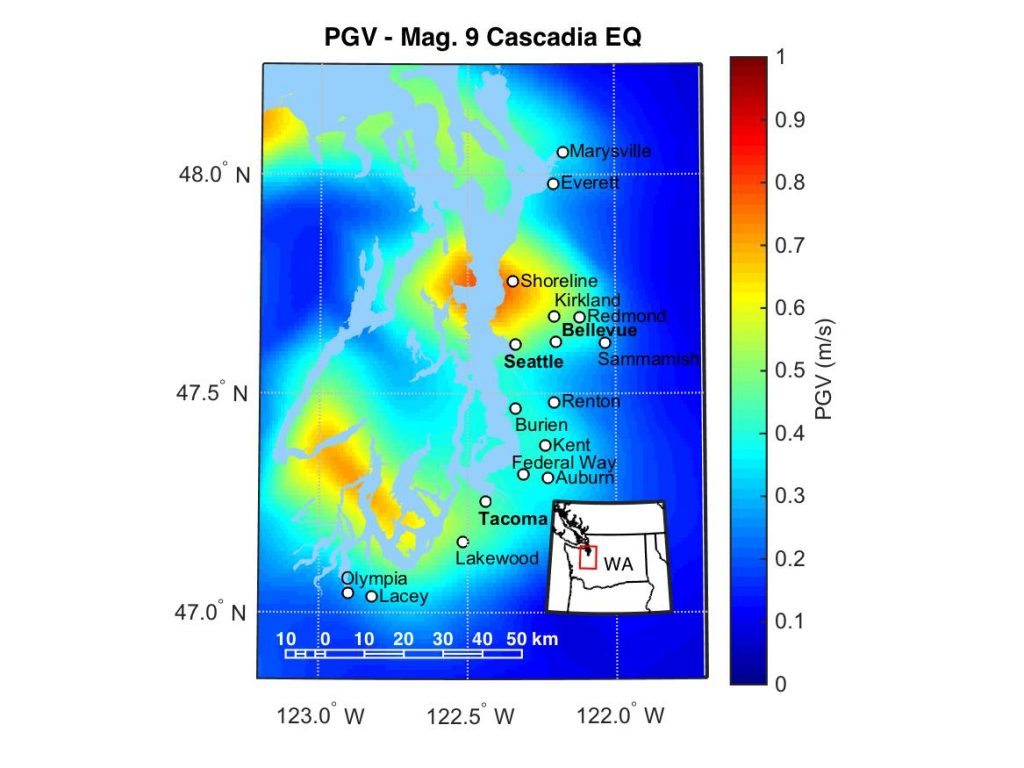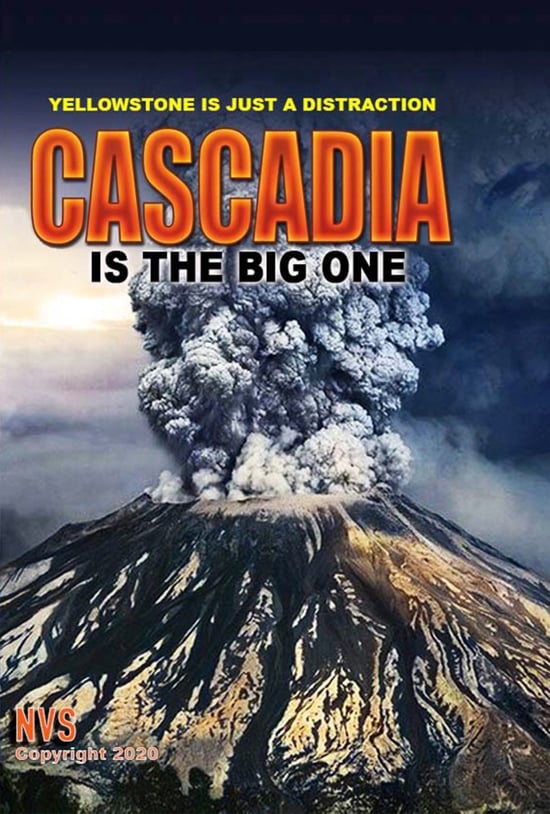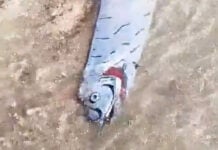Cascadia has experienced major earthquakes in the past.
Should another occur today, the region’s cities would feel intense shaking — some more than others. So what about Seattle, Tacoma and Olympia?
Although Washington State’s Puget Sound has been shaken every few decades, damage in the region’s largest cities, including Seattle, Tacoma and Olympia, has only ever been modest.
However, an enormous threat lurks just off the coast of the Pacific Northwest. Here, the Juan de Fuca tectonic plate is jammed beneath the North American plate at a rate of a few centimeters per year.
The interface of the two plates is the Cascadia subduction zone, a fault that has generated magnitude-8.0+ earthquakes over intervals spanning many centuries.
The region’s last major earthquake was in 1700, when an approximate magnitude-9.0 earthquake ruptured the full length of the fault, which extends from off the coast of Northern California to Vancouver Island in Canada.
A repeat of the 1700 earthquake today would cause extensive damage throughout the Pacific Northwest. The risk is particularly high in the Puget Sound, where major population centers are growing directly in harm’s way.

A geologic mystery is solved
The 1700 quake occurred two centuries before seismometers were invented and widely installed. We therefore do not have direct measurements of how large the earthquake was.
Magistrate records from Eastern Japan and Native American oral histories from the Pacific Northwest do, however, suggest a large wave of water swept through these regions around this time.
It wasn’t until 20th century researchers compared these records with coastal geology that the source of this tsunami was identified: a magnitude-9.0 earthquake on the Cascadia subduction zone (Atwater et al., 2005; Satake et al., 2003; Ludwin et al., 2005).
A disaster in the making
Since the start of European settlement in the late 19th century, the population of the Pacific Northwest has grown into the millions, and the region is currently experiencing one of the largest population booms in the country.
Within Washington State’s Puget Sound region, urbanization has transformed muddy tidal flats into the bustling port cities of Seattle, Tacoma and Olympia, which have rapidly grown into huge tech and manufacturing hubs.
Most of this urbanization took place prior to the realization of the danger posed by a possible megathrust earthquake.

Knowing how the 1700 event shook the region would provide valuable information about which areas need more preparation before the next great Cascadia earthquake.
While there are not seismological recordings of the last Cascadia earthquake, seismologists can simulate ground shaking using information about the fault and observations from other subduction zone earthquakes.
With these results, we can see which parts of the Puget Sound would experience the strongest shaking during a possible repeat of the 1700 quake.
Estimated shaking in the Puget Sound

Simulated peak ground velocities from a magnitude-9.0 earthquake on the Cascadia Subduction Zone highlight differences in the effect of such an earthquake throughout the Puget Sound region.
The peak ground velocity describes the maximum speed at which the ground moves during an earthquake and typically correlates well with felt shaking intensity — and damage — during large earthquakes.
As a point of comparison, a peak ground velocity of 1.1 miles per hour (0.5 meters/second) was strong enough to tip over train cars during the 1906 magnitude-7.0 San Francisco earthquake (Veeraraghavan et al., 2019).
Since we do not know where the hypocenter was or the exact slip distribution for the 1700 earthquake, what’s shown in the map is the average peak ground velocity from thirty different rupture scenarios, each considering a different hypocenter and slip distribution.
While the peak ground velocity for a city may change from one rupture scenario to another, the relative response between cities is often similar, since shaking is strongly influenced by geologic structure and fault location.
Using these data, we can estimate which cities with a population greater than 50,000 in the Puget Sound region are expected to experience the strongest shaking.

These results might not be immediately intuitive. After all, Olympia, which is the closest of the cities to the megathrust fault, is estimated to experience the least severe shaking; at the same time, many cities on the east side of the Puget Sound — further away from the fault — experience much stronger shaking.
This oddity may be attributed to the effect of sedimentary basins, which trap and amplify seismic waves.
Shoreline sits near the middle of the Seattle Basin, which is why it is estimated to experience the strongest shaking, with a peak ground velocity around 1.6 miles per hour (0.7 meters/second).
Cities with the lowest amount of estimated shaking are either located away from sedimentary basins or are further to the east. Topping this list are Olympia, Everett and Sammamish, all of which are estimated to experience a peak ground velocity around 0.7 miles per hour (0.3 meters/second).
It is important to emphasize that when it comes to earthquake damage, the estimated shaking mapped above will only be part of the equation.
Factors like construction quality and local soil conditions will play an important role in how much a structure is damaged. For instance, a well-built house on hard rock in a strong shaking area might fare better than a poorly built house on sand or artificial fill in a weak shaking area.
The results presented here do not consider localized soil conditions, so shaking at a given location may end up being stronger (or weaker) than what is shown.
It is also important to point out that the city with the “weakest” shaking in this analysis (Olympia) is still estimated to have a peak ground velocity near 0.7 miles per hour (0.3 meters/second), which is strong enough to be widely felt and cause modest localized damage.
But Cascadia isn’t the only dangerous fault in the Puget Sound’s region:
Preparing for the next earthquake
When the subduction zone ruptures again, the earthquake will only be the start of the disaster.
It is expected that a repeat of the 1700 earthquake would cripple infrastructure throughout the entire Pacific Northwest, and for many weeks following the disaster, citizens of the area will have to learn to live without access to fully functioning roads, water, electricity and sewage, according to the Cascadia Region Earthquake workgroup 2013 report.
This is doubly true for more remote regions of Western Washington and Oregon.
Cascadia big one
- The estimated likelihood of another magnitude-9.0 earthquake on the Cascadia Subduction Zone over the next 50 years sits at around 15% (Goldfinger et al., 2017).
- The likelihood of a magnitude-8.0 or larger earthquake in the same time period, which would partially rupture the fault and still do a significant amount of damage, is around 40% (Goldfinger et al., 2012).
Also consider that a magnitude-9.0 mainshock can produce an approximately magnitude-8.0 aftershock, as happened 30 min after the magnitude-9.0 Tohoku, Japan, megathrust earthquake in 2011.
It’s now very important that those living in the Pacific Northwest have a personal disaster plan. I would recommend having at least a cache of water and non-perishable foods that will sustain you and your family for up to fourteen days. Other suggestions on building an emergency plan may be found at the Washington Emergency Management website.
In the meantime, you can also watch this informative and spectacular documentary ever done on this subject here (click on the image below).
More earthquake news on Strange Sounds and Steve Quayle. [Temblor]













U.S. Cell Phone Networks Under Attack; MAJOR OUTAGES
My prediction of Internet shut down is coming ? We hope is not middle of mega quakes?
Police Stops: What to Do If You Are Pulled Over
What you do and say during a traffic stop can be big.
When a police officer begins to pull you over, what you do and say can have a huge effect on any legal proceedings that might follow. Whether the traffic stop ends in a simple moving violation or an arrest for a more serious crime, your choices are critical.
When You See the Police Car
If a police car is following you with its siren blaring or emergency lights flashing, pull over to the right quickly (but safely) and come to a complete stop in a safe place.
Pulling over right away isn’t an admission of guilt. It just means that you were alert to everything that was happening around you. Also, by stopping as soon as you can, you’ll have a better chance of figuring out exactly where and how the officer says you violated any traffic laws. This information can be useful should you and a lawyer later need to prepare a defense.
Pull over in a way that will be most likely to calm down an angry or annoyed traffic officer. Use your turn signal to indicate any lane changes from left to right, and slow down fairly quickly, but not so quickly that the officer will have to brake to avoid hitting you. Pull over as far to the right as possible, so that the officer won’t have to worry about being clipped by vehicles in the right lane when coming up to your window.
What to Do Right After You Stop
After you’ve pulled over to a safe spot, you should normally turn off your engine. At this point, you might want to show the officer a few other token courtesies. You have little to lose and perhaps something to gain.
Roll down your window all the way. Put out a cigarette if you have one and discard any chewing gum (within the car). You might also want to place your hands on the steering wheel, and, if it’s dark, turn on your interior light. These actions will tend to allay any fears the officer might have. After all, police officers have been killed in traffic-stop situations, and the officer’s approach to the vehicle is potentially the most dangerous moment.
Your dignity might be offended a little at this point, but remember that you’re just doing a few simple things to put the officer in an optimal frame of mind.
Also, stay in the car until and unless the officer directs you to get out. Finally, don’t start rummaging through your back pocket for your wallet and license, or in your glove compartment for your registration, until the officer asks you for them. For all the officer knows, you could be reaching for a weapon.
Can the Officer Create Excuses to Search?
In general, a police officer who stops you for a traffic violation is not allowed to search your vehicle. But there are several exceptions to this general rule.
After pulling you over, an officer will watch for any sort of “furtive movement.” A sudden lowering of one or both shoulders, for example, will tip the officer off that you’re attempting to hide something under the seat.
An officer enforcing a traffic stop isn’t looking just for furtive movements. Officers will look for anything incriminating that’s in “plain view” (like open beer or wine bottles, joints, or roach clips). Discovery of one item in plain view often leads to a thorough search that reveals more incriminating or illegal objects.
If you’re arrested and your car is towed, the police may generally make an “inventory search” afterward, even if they have no reason to suspect there’s anything illegal inside.
STATE LAW MIGHT FACTOR IN
This article discusses principles relating to the U.S. Constitution as interpreted by the U.S. Supreme Court. State law can, however, provide more protections.
Staying in the Car and More on Searches
An officer who stops you for an alleged traffic violation has the right to insist that you and your passengers get out of your car. (Pennsylvania v. Mimms, 434 U.S. 106 (1977); Maryland v. Wilson, 519 U.S. 408 (1997).) Clearly, you should get out if asked or instructed to do so. Simply put: You should follow the officer’s directives but begin with the assumption that you should remain in the car. And you should also assume that the officer is on alert, ready to interpret a failure to follow instructions as a threat of danger or an attempt to flee.
An officer who has any reason to suspect that you might be dangerous has a right to conduct a quick “pat-down” search of your outer clothing. (Arizona v. Johnson, 555 U.S. 323 (2009).) Upon feeling any weapon-like object during the pat-down, the officer may reach in and get it. The officer can also seize anything during a proper frisk for weapons that obviously feels like contraband.
Also, if the police officer reasonably believes you’re dangerous and might gain control of weapons, the officer may search areas within the passenger compartment in which a weapon could be placed or hidden. (Michigan v. Long, 463 U.S. 1032 (1983).)
We do request in this darkest history of USA , and all COPS are under high stress and if you follow this article things will get calmer. I was stopped for a stop sign in on of USA state ,that was long long time ago and police came closed all my ways back front and sides and i followed this articles , i put complain
with police department and i went court not guilty and officer did not show up my ticket was dropped. I beg all USA and world
follow simple rules. Accept North Korea and Cuba and Iran and
Saudi Arabia because are rogue states?
Well HAARP is so active and we have had 6.8 quakes , last night
and Seattle is under siege and best thing is shake down 9.3 for over 12 minutes and guess problem is solved and all free zone will go under water? Is that a scenario?
I hope this scenario won’t happen
Japan is most likely the closest example: the West Coast, has to be shaken, but I do not think, it would be shaken more than Japan.(Tsunami including).
Hope the west coast is ready and prepared for it!
I hope they are ready too.